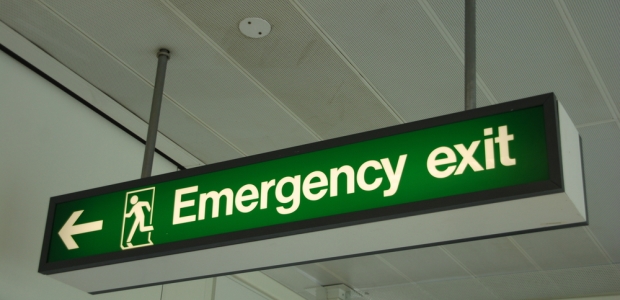
Evacuating Tall Buildings: Life-Saving Solutions
There is no typical emergency. However, those in an emergency use the acronym RED: React to your surroundings and take note of active threats or escape routes and then Evaluate practical options. Finally, Decide on the best solution.
- By Melissa Brown
- Mar 16, 2015
Tall buildings add to a city's skyline and offer affordable living to those in urban areas. However, the nature of the towering structures warrants focus on particular areas of safety, such as proper and injury-free evacuation.
Fires, roving criminals, and other hazards warrant evacuations, and living in a high rise safe and sound necessitates special awareness. Read the following to improve your sense of awareness and increase the number of safety solutions regarding an evacuation. Get others involved and create a plan of action.
Know the Protocol
Most buildings have specific protocols in place to address different emergencies. For example, a criminal on the premises may warrant a mass text message sent from the building manager that urges residents to stay inside their apartments until authorities arrive. There are apps for mobile devices that are simple to set up for this. Alternatively, a fire may require quick egress while minding the facts about the inferno's location.
Designate a Leader
Most missions fail due to a lack of leadership. Frantic situations lead to harmful incidents when there is no direction or designated leader to give quick, assertive, and authoritative orders to those who are surprised, frantic, and afraid. Some maintain a sound mind during emergencies while others do not, and most have no idea how they'll react. Designating a leader ensures a surer path to safety during a number of evacuation scenarios.
Have a Chain of Communication
Create a chain of communication with elected safety leaders or officials using smart phones, mobile devices, pagers, and devices to communicate, relay orders, and confirm the safety status of residents.
Immediate Reporting
Teachers and safety officials quickly do head counts during fire drills and safety evacuations. Knowing those present and who still requires assistance is a primary concern. Such information helps firefighters, police, and other safety officials evacuate residents and pets, as well as to ensure there are no injuries or deaths.
Safety is a Muscle
Maintaining great safety is not unlike building muscle. Strength doesn't come without challenge. Moreover, as experienced weightlifters know, muscles soon grow accustomed to repetition, which warrants new trials for optimal growth. Make the safety standards in your building stronger by scheduling regular fire drills and informing residents of proper protocols, specific roles, and responsibilities. Empower residents with tools of safety awareness. Get in touch with local fire departments, many of which will have access to materials that can assist.
Mind the Season
Safety protocols may change by the season, especially in areas prone to hurricanes, blizzards, etc. Be sure to understand how the change of season influences safety protocols and evacuation procedures. Additionally, spread awareness throughout the building by posting reminders and by sending mailed letters and email alerts to residents, especially those who live in the building for seasons at a time.
Don't Make Assumptions
Establishing protocols and spreading awareness is so important because common sense can be the enemy during an emergency, and it's wrong to assume in times of panic. For example, while it may be a fearful impulse to flee the building, it could be incredibly safer to stay put and wait for firefighters to arrive. Likewise, knowing proper protocols ahead of time makes it easier to tell the difference between those who are making wrong versus right decisions. Unfortunately, in emergencies, we become susceptible to the decisions of others who may accidentally put us in added danger.
There Are No Typical Emergencies
As those enduring emergencies can attest, the "real thing" is unlike drills, and evacuation routes and opportunities for escape may change due to atypical circumstance, such as operational malfunctions, physical damage, etc. There is no typical emergency. However, those in an emergency use the acronym RED: React to your surroundings and take note of active threats or escape routes and then Evaluate practical options. Finally, Decide on the best solution; be steady and secure in your commitment. In some cases, you may have to pick the least threatening of two poor options to find ultimate safety.
Maintain and Check Equipment
A number of buildings are equipped with safety hatches, evacuation chairs, and fire escapes for times of quick egress. However, the ability to ensure safety is only as reliable as the frequency of maintenance checks. A rusty, unhinged, and structurally unsound fire ladder will cause more injuries in an emergency. Speak to building managers about regular safety checks and each resident's role and duty.
Help Those with Disabilities
Those with mental and/or physical disabilities may need assistance or special forms of alert in times of emergency. For example, those who are deaf will not hear alarms, and while they have a heightened sense of smell and sight, may be at a disadvantage during fires, criminal raids, etc. Likewise, those in wheelchairs or with mobility issues will need added time to ensure a safe evacuation. Helping those with disabilities may entail using door or window markers, along with making local authorities aware of those with special disabilities.
Melissa Brown is a safety officer for a busy apartment high-rise in New York City. An avid blogger, she enjoys sharing what has worked for her in the past. Her articles appear on office, business, health, and safety blogs. See http://evacuscape.com/ for more information on evacuation chairs available from Evacuscape, a Toronto provider.